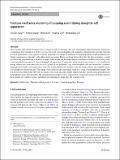Fracture mechanics modeling of popping event during daughter cell separation
Author(s)
Jiang, Yuxuan; Liang, Xudong; Guo, Ming; Cao, Yanping; Cai, Shengqiang
DownloadAccepted version (1.162Mb)
Open Access Policy
Open Access Policy
Creative Commons Attribution-Noncommercial-Share Alike
Terms of use
Metadata
Show full item recordAbstract
Most bacteria cells divide by binary fission which is part of a bacteria cell cycle and requires tight regulations and precise coordination. Fast separation of Staphylococcus Aureus (S. Aureus) daughter cells, named as popping event, has been observed in recent experiments. The popping event was proposed to be driven by mechanical crack propagation in the peripheral ring which connected two daughter cells before their separation. It has also been shown that after the fast separation, a small portion of the peripheral ring was left as a hinge. In the article, we develop a fracture mechanics model for the crack growth in the peripheral ring during S. Aureus daughter cell separation. In particular, using finite element analysis, we calculate the energy release rate associated with the crack growth in the peripheral ring, when daughter cells are inflated by a uniform turgor pressure inside. Our results show that with a fixed inflation of daughter cells, the energy release rate depends on the crack length non-monotonically. The energy release rate reaches a maximum value for a crack of an intermediate length. The non-monotonic relationship between the energy release rate and crack length clearly indicates that the crack propagation in the peripheral ring can be unstable. The computed energy release rate as a function of crack length can also be used to explain the existence of a small portion of peripheral ring remained as hinge after the popping event. ©2018 Springer-Verlag GmbH Germany, part of Springer Nature.
Date issued
2018-05Department
Massachusetts Institute of Technology. Department of Mechanical EngineeringJournal
Biomechanics and Modeling in Mechanobiology
Publisher
Springer Nature
Citation
Jiang, Yuxuan et al., "Fracture mechanics modeling of popping event during daughter cell separation." Biomechanics and Modeling in Mechanobiology 17, 4 (May 2018): 1131–1137 ©2018 Authors
Version: Author's final manuscript
ISSN
1617-7940